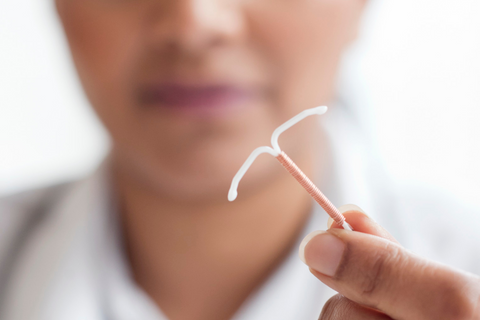Be Careful: Using Menstrual Cup With IUD Tip

The blend of intrauterine devices (IUDs) and menstrual cups has stirred up quite a buzz among those looking for eco-friendly and practical menstrual solutions. Well, just like on my TikTok and YouTube, we’re gonna be diving into the nitty-gritty of using a menstrual cup with an IUD. It's like figuring out the perfect dance moves for your reproductive health – understanding how they work together, unraveling any potential hiccups, and making sure you're armed with evidence-based knowledge for smart decision-making.
Understanding Menstrual Cups and IUDs
Navigating the world of menstrual care and birth control is like decoding a mystery picture. Now, imagine throwing a menstrual cup and an intrauterine device (IUD) into the mix – it's like exploring uncharted territory. I’m ready to peel back the layers to understand the dynamic duo of menstrual cups and IUDs. Think of it as getting to know two unique players in your reproductive story – the trusty cup that's got your back during your period and the IUD, your low-maintenance pregnancy prevention pal.

How Menstrual Cups Work
Menstrual cups are flexible, bell-shaped devices made of medical-grade silicone or rubber. They are designed to collect menstrual blood, forming a seal against the walls of the vagina.
The Basics of Intrauterine Devices (IUDs)
IUDs are T-shaped devices inserted into the uterus to prevent pregnancy. There are copper IUDs and hormonal IUDs, each with distinct characteristics. This form of birth control is often preferred by women who do not want to remember to take a birth control pill daily, change a weekly patch, or remove the ring monthly. Hormonal IUDs are also preferred for woman who have heavy periods.
The Compatibility Dilemma: Can You Use a Menstrual Cup with an IUD?
The question on the table is straightforward: can these two coexist without complications? We'll explore potential considerations and challenges, addressing the interaction between the IUD strings and the seal created by the menstrual cup. Consider it a practical explanation of whether these two reproductive tools can comfortably share the stage or if adjustments are needed for a seamless partnership.
IUD Strings and Menstrual Cups
There are a few things you want to know when it comes to intrauterine contraception or IUDs. IUDs have strings that extend into the vaginal canal. Inserting a menstrual cup raises concerns about potential interference with these strings, affecting the IUD's position.

Seal of the Cup and Expulsion Risks
Creating a seal at the base of the cup is crucial for proper functioning. However, the slight suction may pose an increased risk of IUD expulsion, especially during the early stages after insertion.
IUD Type Matters
Different types of IUDs may influence the compatibility with menstrual cups. Understanding your specific IUD type is an important consideration before opting for concomitant use.
For instance, hormonal IUDs, such as the Mirena or Skyla, often come with thinner and more flexible strings compared to copper IUDs like Paragard. These differences in string composition and placement can affect how the menstrual cup interacts with the IUD.
Hormonal IUDs, with their softer and more pliable strings, may pose less risk of interference with the menstrual cup during insertion and removal. However, individuals using copper IUDs may need to be extra cautious, as the firmer strings could potentially dislodge or interfere with the cup's suction seal.
The size and shape of the menstrual cup relative to the cervix and uterus can also influence compatibility with different types of IUDs. Cups that are too large or rigid may exert more pressure on the IUD strings or disrupt the device's positioning within the uterus.
The Latest Insights: What Science Says
A recent systematic review analyzed the current specific evidence on menstrual cup use with IUDs. Findings suggest a nearly fourfold increased risk of IUD displacement in users of menstrual cups.
Studies indicate that concurrent menstrual cup use may lead to an increased risk of expulsion. Healthcare providers emphasize the importance of considering these factors.
Using Menstrual Cup with IUD Tips
So, you've read this far and have decided to embrace the dynamic duo of menstrual cups and IUDs, but now you're wondering, "How can I make this partnership work seamlessly?" Fear not, I've got you covered sis! Here are some practical tips to navigate the world of using a menstrual cup with an IUD.
Know Your IUD Type
Before using a menstrual cup, know your IUD type. Hormonal and copper IUDs have different considerations. Hormonal IUDs have flexible strings, while copper ones are firmer. Ensure the cup doesn't interfere with the IUD or cause discomfort. Consider the cup size and shape. Consult your healthcare provider for personalized guidance.
Choose the Right Menstrual Cup
Not all cups are created equal. Opt for a menstrual cup that suits your body and flow. There are many menstrual cup brands. Consider factors like the different sizes, flexibility, and the material used. Lenacup, Saalt Cup, and the very popular brand Diva Cup offer various options.
Check IUD Strings Regularly
Keep tabs on your IUD strings, especially during your period. Ensure they remain in their proper place and haven't become entangled with the menstrual cup. Regular checks help prevent any unexpected surprises, especially during your period. Ensure they remain in their proper place and haven't become entangled with the menstrual cup. Regular checks help prevent any unexpected surprises.

To check your IUD strings, gently insert your clean fingers into your vagina until you feel the strings. They should feel like thin threads protruding from the cervix. If you cannot locate the strings or if they feel unusually long or short, it's essential to contact your healthcare provider for further evaluation.
Master the Removal Technique
When removing your menstrual cup, do so with care. Break the seal by pinching the base of the cup and gently wiggling it from side to side. This minimizes the suction effect and reduces the risk of interfering with your IUD strings.
Consult Your Healthcare Provider
Your healthcare provider is your go-to resource for personalized advice. Discuss your decision to use a menstrual cup alongside your IUD during your regular check-ups. They can offer tailored guidance based on your specific health situation.
Be Mindful of Menstrual Flow
If you experience heavy periods, be mindful of the potential suction effect when using a menstrual cup. The suction effect refers to the cup forming a tight seal against the vaginal walls, which can sometimes happen when the cup is inserted and positioned incorrectly or when it's too large for your body.
When a menstrual cup forms a strong suction seal, it can make removal more challenging and potentially cause discomfort or even injury if not handled correctly. This is particularly important for individuals with heavy periods, as the cup may collect a significant amount of menstrual fluid, leading to increased suction force.
Additionally, you may want to consider emptying the cup more frequently to prevent it from becoming too full and creating excessive suction. It's also helpful to be patient and gentle when removing the cup, using the designated grip or stem to break the seal before gently pulling it out.
Follow Up with Regular Appointments
Schedule routine follow-up appointments with your healthcare provider. This is normally yearly for patients, and they will check your IUD then. These visits allow for ongoing assessment of your IUD's placement and address any concerns or questions you may have about using a menstrual cup.
Educate Yourself
Stay informed about the latest research and insights regarding menstrual cups and IUDs. Understanding the current evidence will empower you to make informed decisions about your reproductive health.
Using a menstrual cup with an IUD can be a harmonious experience with the right knowledge and approach. By incorporating these tips into your routine, you can confidently navigate this intersection of menstrual hygiene and contraception for a hassle-free and comfortable period experience.
In reproductive healthcare, using menstrual cups alongside IUDs comes with a mix of advantages and hurdles. Right now, there's still a bit of a blank space in the research that needs more digging, but what we do know points to some potential risks. When making decisions, think about things like the type of IUD you've got, the brand of your cup, and how you take it out.
Don’t forget to chat with a healthcare professional to sort out your specific concerns and make sure these two birth control buddies get along smoothly. As we all aim for a sustainable and effective game plan for periods, let the facts and expert advice lead the way for a hassle-free journey in reproductive health.


Leave a comment